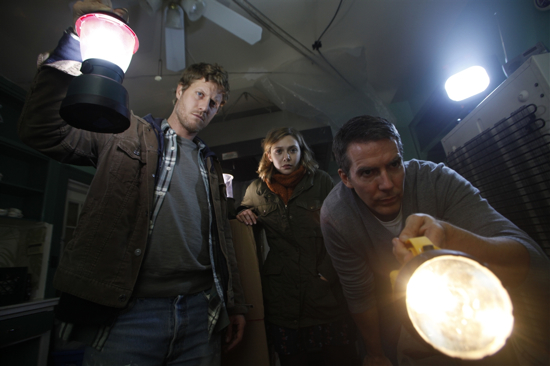Even without bemoaning a remake produced only a year after the original, husband and wife duo Chris Kentis and Laura Lau’s latest collaboration (their previous effort being 2003’s low-budget fish tale Open Water) seems the epitome of all that is gratingly wrong about modern American horror. Depicting a ‘real time’ living nightmare, purportedly shot in one continuous take (though it was actually more like ten, according to Kentis), it slovenly becomes a case of clichés convoluted in delivery, lazy in plotting, and most definitely gimmicky.
In the second of two roles that brought her some attention at last year’s Sundance – the other being a decidedly more haunting Martha Marcy May Marlene – Elizabeth Olsen plays Sarah, a young woman returning to a decrepit lakeside summer home to fix it up with her father (Adam Trese) and an over-attentive uncle (Eric Sheffer Stevens). After a surprise visit from a childhood friend, in which obvious plot twists are signposted to eye-rolling effect, Sarah begins to hear some noises in the upstairs rooms. She sends her poor ol’ dad up to investigate. What ensues is a masterclass in mediocrity, plenty of screaming and running around, and even some oddly heavy-handed attempts at dealing with serious issues.
Based on the $6000 Uruguayan flick The Silent House (La Casa Muda) and one particularly tired metaphor of unlocking the door to suppressed memory, Kentis and Lau make the mistake of focusing too hard on the conceptual rather than emotional aspects of the story. Though only intermittently effective, the original demonstrated a zeal for atmosphere and use of dead space (ironically akin in many ways to the video game Dead Space), marrying disjointed piano couplets with some tangible claustrophobia. The American remake settles for run-of-the-mill ‘jump’ scares which occur as regular as a bum on prunes, always the result of loud noises, unimaginative scoring, and people appearing suddenly from off-screen in that way that horrors do. The ‘jumps’ accumulate in a movie that offers little to the evolution of an experiment-friendly genre (The Cabin In The Woods being one fine recent example).
It is a mild ’empathetic’ horror, rather than a ‘sympathetic’ one. As you watch you can understand how the situation might be scary if it was happening to you, but you don’t get the feeling or urgency that the horror is being inflicted directly upon you. Instead of thinking, This is frightening, we are forced into the less visceral thought, This might be frightening if I was under that table. And despite all the technical cleverness, frequent use of close-ups and reversals, it lacks the claustrophobic feel it is desperate to create, particularly as the focus of the horror is usually just a pair of denim jean legs moving about under said table.
Though Olsen has again been praised for her performance, the technical demands of the shoot are also noticeably obtrusive. From the outset, even after a promising opening shot, you can see the actors realising their cues and clicking into place at each turn, waiting for the camera to follow, and generally acting a little robotically. Add to that some brutally simplistic writing – often to the effect of: "What’s going on? You have blood on you! Where’s your dad?" – and the short running time is welcome.
Often it feels like a stage production, a filmed play in the vein of Hitchcock’s lacklustre Rope (1948), with the roving camera going from set-piece to set-piece with this drawn-out effect that dilutes any build of tension. One notable sequence particularly guilty of this involves Sarah breaking free from the house and running through some bushes. We will never know why Kentis and Lau had their cinematographer drag his probably expensive camera over the grassy knolls and shake it rabidly, all in the name of misfiring immersion. Is this preferable to the smash cuts of other mainstream horrors? That is debatable. But the lack of conspicuous editing, though the sole selling-point, is a weakness rather than a strength. Cinephiles will still be looking for the moment where they stitched two sequences together, and they are not hard to spot. Sadly, the transitions are reminiscent of the ‘just roll the camera behind a pillar’ technique of Running Time (1997), another stab at the ‘single-take’ sub-genre.
Theoretically, you can see how it could have worked on paper. We have an intriguing concept of discovering repressed memories in real-time, revealed to the protagonist and audience simultaneously. Admittedly, they threw in Olsen with the prescript ‘horror tank top’ plus ill-fitting bra. In a pretty haunted-looking house. But presumably the paper ran out before they got to the third act, which ticks all the boxes if what you’re looking for is a film that confuses convolution with mystery, before it goes on to offer a critique of itself, having Olsen leg it around in her skimpy top (one of the Plot Keywords on IMDb is ‘cleavage’) before twisting into something that it seems unsettlingly incapable of dealing with in any meaningful or worthwhile way. But to reveal any more would be a spoiler.
The twists amount to a film venturing to transform itself into a psychological/existential thriller, a drama even, a journal of half-remembered abuse. But it throws this in too late to convince. The subsequent attempts at surrealist imagery fail to interrogate any of the half-baked issues Silent House raises, instead showing them up as cheap trickery. All of which adds to the excessively commercial aftertaste. Kentis and Lau have re-appropriated a somewhat intriguing setup and achieved less on a bigger budget – which may often be the case with remakes – with only shrewd marketing to set the piece apart.



